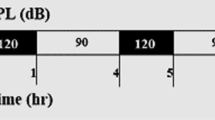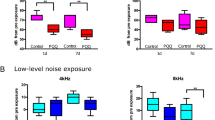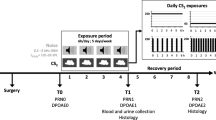Abstract
A previous study showed that people living in urban areas are generally exposed to low-frequency noise (LFN) with frequencies below 100 Hz and sound levels of 60–110 dB in daily and occupational environments. Exposure to LFN has been shown to affect balance in humans and mice. However, there is no information about prevention of LFN-mediated imbalance because of a lack of information about the target region based on health risk assessment of LFN exposure. Here, we show that acute exposure to LFN at 100 Hz, 95 dB, but not at 85 dB or 90 dB, for only 1 h caused imbalance in mice. The exposed mice also had decreased cervical vestibular-evoked myogenic potential (cVEMP) with impaired activity of vestibular hair cells. Since imbalance in the exposed mice was irreversible, morphological damage in the vestibules of the exposed mice was further examined. The exposed mice had breakage of the otoconial membrane in the vestibule. LFN-mediated imbalance and breakage of the otoconial membrane in mice were rescued by overexpression of a stress-reactive molecular chaperone, heat shock protein 70 (Hsp70), which has been shown to be induced by exposure of mice to 12 h per day of LFN at 95 dB for 5 days. Taken together, the results of this study demonstrate that acute exposure to LFN at 100 Hz, 95 dB for only 1 h caused irreversible imbalance in mice with structural damage of the otoconial membrane as the target region for LFN-mediated imbalance, which can be rescued by Hsp70.






Similar content being viewed by others
References
Agrawal Y, Carey JP, Della-Santina CC, Schubert MC, Minor LB (2009) Disorders of balance and vestibular function in US adults: data from the National Health and Nutrition Examination Survey, 2001–2004. Arch Intern Med 169(10):938–944. https://doi.org/10.1001/archinternmed.2009.66 (PMID: 19468085)
Berglund B, Hassmén P (1996) Sources and effects of low-frequency noise. J Acoust Soc Am 99(5):2985–3002. https://doi.org/10.1121/1.414863 (PMID: 8642114)
Bisdorff A, Bosser G, Gueguen R, Perrin P (2013) The epidemiology of vertigo, dizziness, and unsteadiness and its links to co-morbidities. Front Neurol 4:29. https://doi.org/10.3389/fneur.2013.00029 (PMID: 23526567)
Evans MJ, Tempest W (1972) Some effects of infrasonic noise in transportation. J Sound Vib 22(1):19–24. https://doi.org/10.1016/0022-460X(72)90840-1
Halmagyi GM, Colebatch JG, Curthoys IS (1994) New tests of vestibular function. Baillieres Clin Neurol 3:485–500 (PMID: 7874404)
Harrison RV (2015) On the biological plausibility of Wind Turbine syndrome. Int J Environ Health Res 25(5):463–468. https://doi.org/10.1080/09603123.2014.963034 (PMID: 25295915)
Hasson T, Gillespie PG, Garcia JA, MacDonald RB, Zhao Y, Yee AG, Mooseker MS, Corey DP (1997) Unconventional myosins in inner-ear sensory epithelia. J Cell Biol 137(6):1287–1307 (PMID: 9182663)
Huang M, Sage C, Li H, Xiang M, Heller S, Chen ZY (2008) Diverse expression patterns of LIM-homeodomain transcription factors (LIM-HDs) in mammalian inner ear development. Dev Dyn 237(11):3305–3312. https://doi.org/10.1002/dvdy.21735 (PMID: 18942141)
Kawashima Y, Géléoc GS, Kurima K, Labay V, Lelli A, Asai Y, Makishima T, Wu DK, Della Santina CC, Holt JR, Griffith AJ (2011) Mechanotransduction in mouse inner ear hair cells requires transmembrane channel-like genes. J Clin Invest 121(12):4796–4809. https://doi.org/10.1172/JCI60405 (PMID: 22105175)
Lambert FM, Bras H, Cardoit L, Vinay L, Coulon P, Glover JC (2016) Early postnatal maturation in vestibulospinal pathways involved in neck and forelimb motor control. Dev Neurobiol 76(10):1061–1077. https://doi.org/10.1002/dneu.22375 (PMID: 26724676)
Lanneau D, Wettstein G, Bonniaud P, Garrido C (2010) Heat shock proteins: cell protection through protein triage. Sci World J 10:1543. https://doi.org/10.1100/tsw.2010.152 (PMID: 20694452)
Lundberg YW, Xu Y, Thiessen KD, Kramer KL (2015) Mechanisms of otoconia and otolith development. Dev Dyn 244(3):239–253. https://doi.org/10.1002/dvdy.24195 (PMID: 25255879)
Matsuda M, Hoshino T, Yamakawa N, Tahara K, Adachi H, Sobue G, Maji D, Ihn H, Mizushima T (2013) Suppression of UV-induced wrinkle formation by induction of HSP70 expression in mice. J Invest Dermatol 133(4):919–928. https://doi.org/10.1038/jid.2012.383 (PMID: 23096703)
May LA, Kramarenko II, Brandon CS, Voelkel-Johnson C, Roy S, Truong K, Francis SP, Monzack EL, Lee FS, Cunningham LL (2013) Inner ear supporting cells protect hair cells by secreting HSP70. J Clin Invest 123(8):3577–3587. https://doi.org/10.1172/JCI68480 (PMID: 23863716)
McFadden SL, Ding D, Jiang H, Salvi RJ (2004) Time course of efferent fiber and spiral ganglion cell degeneration following complete hair cell loss in the chinchilla. Brain Res 997(1):40–51 (PMID: 14715148)
Mimura K, Watanabe K, Okawa S, Kobayashi M, Miyakawa O (2004) Morphological and chemical characterizations of the interface of a hydroxyapatite-coated implant. Dent Mater J 23(3):353–360 (PMID: 15510865)
Miyakawa O, Okawa S, Kobayashi M (2006) Abrading increases oxygen and hardness of titanium surface. Dent Mater J 25(1):13–19 (PMID: 16706291)
Mohr GC, Cole JN, von Guild E, Gierke HE (1965) Effects of low frequency and infrasonic noises on man. Aero Med 36:817–827
Murofushi T (2016) Clinical application of vestibular evoked myogenic potential (VEMP). Auris Nasus Larynx 43(4):367–376. https://doi.org/10.1016/j.anl.2015.12.006 (PMID: 26791591)
Negishi-Oshino R, Ohgami N, He T, Ohgami K, Li X, Kato M (2019) cVEMP correlated with imbalance in a mouse model of vestibular disorder. Environ Health Prev Med 24(1):39. https://doi.org/10.1186/s12199-019-0794-8 (PMID: 31153359)
Neuhauser HK, von Brevern M, Radtke A, Lezius F, Feldmann M, Ziese T, Lempert T (2005) Epidemiology of vestibular vertigo: a neurotologic survey of the general population. Neurology 65(6):898–904. https://doi.org/10.1212/01.wnl.0000175987.59991.3d (PMID: 16186531)
Ninomiya H, Ohgami N, Oshino R, Kato M, Ohgami K, Li X, Shen D, Iida M, Yajima I, Angelidis CE, Adachi H, Katsuno M, Sobue G, Kato M (2018) Increased expression level of Hsp70 in the inner ears of mice by exposure to low frequency noise. Hear Res 363:49–54. https://doi.org/10.1016/j.heares.2018.02.006 (PMID: 16186531)
Ohgami N, Ida-Eto M, Shimotake T, Sakashita N, Sone M, Nakashima T, Tabuchi K, Hoshino T, Shimada A, Tsuzuki T, Yamamoto M, Sobue G, Jijiwa M, Asai N, Hara A, Takahashi M, Kato M (2010) c-Ret-mediated hearing loss in mice with Hirschsprung disease. Proc Natl Acad Sci USA 107(29):13051–13056. https://doi.org/10.1073/pnas.1004520107
Ohgami N, Ida-Eto M, Sakashita N, Sone M, Nakashima T, Tabuchi K, Hoshino T, Shimada A, Tsuzuki T, Yamamoto M, Sobue G, Jijiwa M, Asai N, Hara A, Takahashi M, Kato M (2012) Partial impairment of c-Ret at tyrosine 1062 accelerates age-related hearing loss in mice. Neurobiol Aging 33(3):626.e25–626.e34. https://doi.org/10.1016/j.neurobiolaging.2011.04.002
Ohgami N, Oshino R, Ninomiya H, Li X, Kato M, Yajima I, Kato M (2017) Risk Assessment of Neonatal Exposure to Low Frequency Noise Based on Balance in Mice. Front Behav Neurosci 22:11–30. https://doi.org/10.3389/fnbeh.2017.00030 (PMID: 28275341)
Plumier JC, Ross BM, Currie RW, Angelidis CE, Kazlaris H, Kollias G, Pagoulatos GN (1995) Transgenic mice expressing the human heat shock protein 70 have improved post-ischemic myocardial recovery. J Clin Invest 95(4):1854–1860. https://doi.org/10.1172/JCI117865 (PMID: 7706492)
Pujol R, Pickett SB, Nguyen TB, Stone JS (2014) Large basolateral processes on type II hair cells comprise a novel processing unit in mammalian vestibular organs. J Comp Neurol 522(14):3141–3159. https://doi.org/10.1002/cne.23625 (PMID: 24825750)
Safiulina D, Peet N, Seppet E, Zharkovsky A, Kaasik A (2006) Dehydroepiandrosterone inhibits complex I of the mitochondrial respiratory chain and is neurotoxic in vitro and in vivo at high concentrations. Toxicol Sci 93(2):348–356. https://doi.org/10.1093/toxsci/kfl064 (PMID: 16849397)
Sakakura K, Miyashita M, Chikamatsu K, Takahashi K, Furuya N (2003) Tone burst-evoked myogenic potentials in rat neck extensor and flexor muscles. Hear Res 185:57–64 (PMID: 14599693)
Salt AN, DeMott JE (1999) Longitudinal endolymph movements and endocochlear potential changes induced by stimulation at infrasonic frequencies. J Acoust Soc Am 106(2):847–856. https://doi.org/10.1121/1.427101 (PMID: 10462790)
Sheykholeslami K, Megerian CA, Zheng QY (2009) Vestibular evoked myogenic potentials in normal mice and Phex mice with spontaneous endolymphatic hydrops. Otol Neurotol 30(4):535–544. https://doi.org/10.1097/MAO.0b013e31819bda13 (PMID: 19300299)
Shimizu K, Murofushi T, Sakurai M, Halmagyi M (2000) Vestibular evoked myogenic potentials in multiple sclerosis. J Neurol Neurosurg Psychiatr 69(2):276–277 (PMID: 10960289)
Shojaku H, Zang RL, Tsubota M, Fujisaka M, Hori E, Nishijo H, Watanabe Y (2007) Effects of selective cochlear toxicity and vestibular deafferentation on vestibular evoked myogenic potentials in guinea pigs. Acta Otolaryngol 127(4):430–435. https://doi.org/10.1080/00016480600895136
Simmler MC, Cohen-Salmon M, El-Amraoui A, Guillaud L, Benichou JC, Petit C, Panthier JJ (2000) Targeted disruption of otog results in deafness and severe imbalance. Nat Genet 24(2):139–143. https://doi.org/10.1038/72793 (PMID: 10655058)
Sreenivasan A, Sivaraman G, Parida PK, Alexander A, Saxena SK, Suria G (2015) The clinical utility of vestibular evoked myogenic potentials in patients of benign paroxysmal positional vertigo. J Clin Diagn Res 9(6):1–3. https://doi.org/10.7860/JCDR/2015/9953.6058 (PMID: 26266140)
Takigawa H, Hayashi F, Sugiura S, Sakamoto H (1988) Effects of infrasound on human body sway. J Low Freq Noise Vib 7:66–73 (PMID: 3726296)
Tamura H, Ohgami N, Yajima I, Iida M, Ohgami K, Fujii N, Itabe H, Kusudo T, Yamashita H, Kato M (2012) Chronic exposure to low frequency noise at moderate levels causes impaired balance in mice. PLoS One 7(6):e39807. https://doi.org/10.1371/journal.pone.0039807 (PMID: 22768129)
Yang TH, Young YH (2005) Click-evoked myogenic potentials recorded on alert guinea pigs. Hear Res 205:277–283. https://doi.org/10.1016/j.heares.2005.03.029 (PMID: 15953537)
Yazawa I, Giasson BI, Sasaki R, Zhang B, Joyce S, Uryu K, Trojanowski JQ, Lee VM (2005) Mouse model of multiple system atrophy alpha-synuclein expression in oligodendrocytes causes glial and neuronal degeneration. Neuron 45(6):847–859. https://doi.org/10.1016/j.neuron.2005.01.032 (PMID: 15797547)
Zhao X, Jones SM, Thoreson WB, Lundberg YW (2008a) Osteopontin is not critical for otoconia formation or balance function. J Assoc Res Otolaryngol 9(2):191–201. https://doi.org/10.1007/s10162-008-0117-z( PMID: 18459000)
Zhao X, Jones SM, Yamoah EN, Lundberg YW (2008b) Otoconin-90 deletion leads to imbalance but normal hearing: a comparison with other otoconia mutants. Neuroscience 153(1):289–299. https://doi.org/10.1016/j.neuroscience.2008.01.055 (PMID: 18355969)
Acknowledgements
This study was supported in part by Grants-in-Aid for Scientific Research on Innovative Areas (16H01639 and 18H04975), Scientific Research (A) (15H01743, 15H02588, and 19H01147), (B) (17KT0033) and (C) (25460178, 16K08343, and 17K09156) from the Ministry of Education, Culture, Sports, Science and Technology (MEXT), Mirai-Program Small Start Type from the Japan Science and Technology Agency (JST), DAIKO FOUNDATION, Kobayashi International Scholarship Foundation and AEON Environmental Foundation. The funders had no role in study design, data collection and analysis, decision to publish, or preparation of the manuscript.
Author information
Authors and Affiliations
Corresponding author
Ethics declarations
Conflict of interest
All authors declare to have no actual or potential conflicts of interest.
Additional information
Publisher's Note
Springer Nature remains neutral with regard to jurisdictional claims in published maps and institutional affiliations.
Electronic supplementary material
Below is the link to the electronic supplementary material.
Rights and permissions
About this article
Cite this article
Negishi-Oshino, R., Ohgami, N., He, T. et al. Heat shock protein 70 is a key molecule to rescue imbalance caused by low-frequency noise. Arch Toxicol 93, 3219–3228 (2019). https://doi.org/10.1007/s00204-019-02587-3
Received:
Accepted:
Published:
Issue Date:
DOI: https://doi.org/10.1007/s00204-019-02587-3




